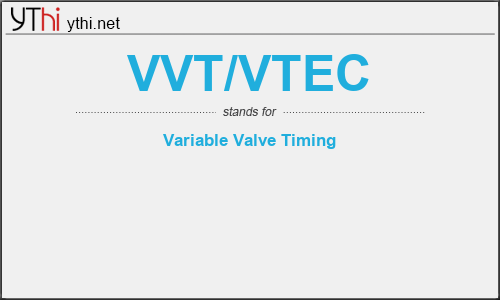What does VVT/VTEC mean? What is the full form of VVT/VTEC?
The full form of VVT/VTEC is Variable Valve Timing
In internal combustion engines, variable valve timing (VVT) is the process of altering the timing of a valve lift event, and is often used to improve performance, fuel economy or emissions. It is increasingly being used in combination with variable valve lift systems. There are many ways in which this can be achieved, ranging from mechanical devices to electro-hydraulic and camless systems. Increasingly strict emissions regulations are causing[citation needed] many automotive manufacturers to use VVT systems.
Two-stroke engines use a power valve system to get similar results to VVT.
After multi-valve technology became standard in engine design, Variable Valve Timing becomes the next step to enhance engine output, no matter power or torque.
As you know, valves activate the breathing of engine. The timing of breathing, that is, the timing of air intake and exhaust, is controlled by the shape and phase angle of cams. To optimise the breathing, engine requires different valve timing at different speed. When the rev increases, the duration of intake and exhaust stroke decreases so that fresh air becomes not fast enough to enter the combustion chamber, while the exhaust becomes not fast enough to leave the combustion chamber. Therefore, the best solution is to open the inlet valves earlier and close the exhaust valves later. In other words, the Overlapping between intake period and exhaust period should be increased as rev increases.
Without Variable Valve Timing technology, engineers used to choose the best compromise timing. For example, a van may adopt less overlapping for the benefits of low speed output. A racing engine may adopt considerable overlapping for high speed power. An ordinary sedan may adopt valve timing optimise for mid-rev so that both the low speed drivability and high speed output will not be sacrificed too much. No matter which one, the result is just optimised for a particular speed.
With Variable Valve Timing, power and torque can be optimised across a wide rpm band. The most noticeable results are:
-
- The engine can rev higher, thus raises peak power. For example, Nissan’s 2-litre Neo VVL engine output 25% more peak power than its non-VVT version.
- Low-speed torque increases, thus improves drivability. For example, Fiat Barchetta’s 1.8 VVT engine provides 90% peak torque between 2,000 and 6,000 rpm.
Moreover, all these benefits come without any drawback.
Variable Lift
In some designs, valve lift can also be varied according to engine speed. At high speed, higher lift quickens air intake and exhaust, thus further optimise the breathing. Of course, at lower speed such lift will generate counter effects like deteriorating the mixing process of fuel and air, thus decrease output or even leads to misfire. Therefore the lift should be variable according to engine speed.
VVT/VTEC
means
Variable Valve Timing![]()
Translate Variable Valve Timing to other language.


Leave a Reply
You must be logged in to post a comment.